NVIDIA’s GeForce GTX 460: The $200 King
by Ryan Smith on July 11, 2010 11:54 PM EST- Posted in
- GPUs
- GeForce GTX 400
- GeForce GTX 460
- NVIDIA
Power, Temperature, & Noise
As we’ve discussed in previous articles, with the Fermi family GPUs no longer are binned for operation at a single voltage, rather they’re assigned whatever level of voltage is required for them to operate at the desired clockspeeds. As a result any two otherwise identical cards can have a different core voltage, which muddies the situation some. All of our GTX 460 cards have an idle voltage of 0.875v, while their load voltage is listed below.
| GeForce GTX 460 Load Voltage | |||||
| Ref 768MB | Ref 1GB | EVGA 768MB #1 | EVGA 768MB #2 | Asus 768MB | Zotac 1GB |
|
0.987v
|
1.025v
|
0.987v
|
1.000v
|
0.987v
|
1.000v
|
Our cards end up ranging from 0.975v to 1.025v, a variance of 0.05v. The 1GB cards with additional functional units on average require more voltage to operate, with the lowest of our samples requiring 1.0v. Otherwise 3 of our 4 768MB cards require 0.975v.
On a side note, since we’re using non-matching 1GB GTX 460s here for SLI testing, we’ve added an asterisk for all the power & temperature results. Our results should be very close to what a proper set of matching reference cards would get, but we can’t guarantee that.
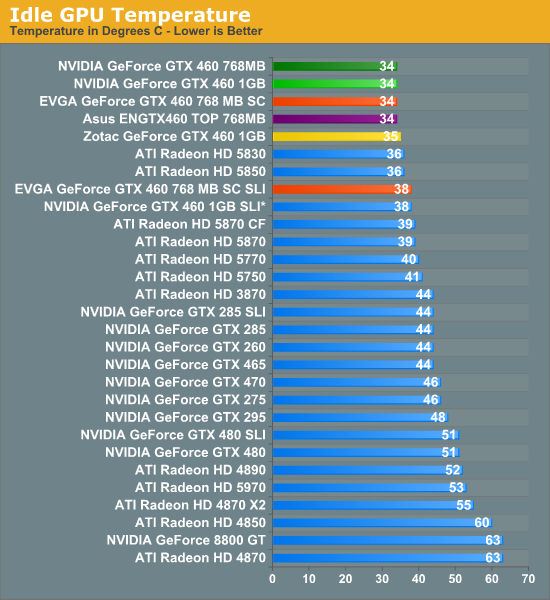
We’ll start with idle temperatures. With an unofficial idle TDP in the 20W range, the GTX 460 series is fairly comparable to the Radeon 5850, but with a more breezy cooler. As a consequence we can see it edge out the rest of our cards here, with all of the open GTX 460s coming in at 34C for idle. Meanwhile the blower-based Zotac card comes in a hair warmer at 35C. Even with a blower, these end up being the coolest mid-range or better cards we have ever tested, besting even the Radeon 5850.
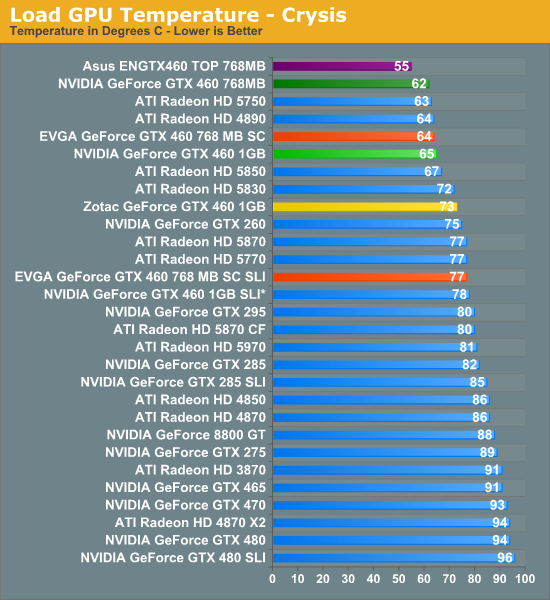
Meanwhile at load the good news continues for the GTX 460 series. The GTX 480 may have been a toasty GPU, but that’s not the case for the GF104 GPU at the heart of the GTX 460 series. Our reference cards do only slightly worse than 60C in Crysis, while Asus’s non-reference card gets that even lower thanks to a more proactive fan. Zotac’s blower doesn’t fare so well here though, coming in at a still respectable but nevertheless higher 73C.
Compared to AMD’s cards the GTX 460 does very well here. The Radeon 5850 is still the sweet spot for a balance of performance and heat, but the GTX 460 manages to do better in terms of heat at a price of lower gaming performance. Meanwhile our Radeon 5830 isn’t even a contender here; as a salvaged Cypress part, it just can’t compete with a part designed for cooler performance from the start. Among all the cards we’ve tested equal to or faster than the 8800GT however, the GTX 460 sets the new bar for how cool a high performance card can operate.

The results with Furmark match those of Crysis, it’s just a bit hotter. The interesting story here is going to be SLI temperatures: our 768MB and 1GB SLI cards hit 89C and 91C respectively. This isn’t a problem for NVIDIA’s GPUs (we see single GTX 480 cards do worse) but it’s a massive jump from a single card. For these reasons we would strongly suggest keeping these cards further spaced apart if you have a motherboard that supports it. The GTX 460 reference cooler just isn’t up to the task of pulling in fresh air if it’s next to another card.
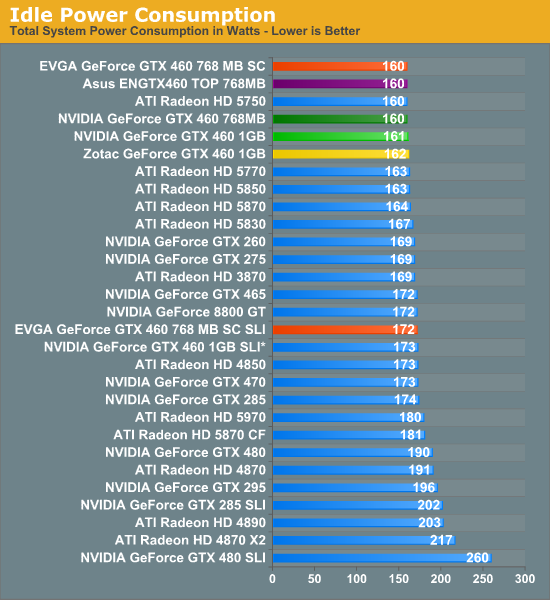
Our idle power numbers continue to lower the bar for GPUs of this performance class, although at this point we’re hitting the efficiency limits of our PSU at low wattages. Our 768MB GTX 460s end up sharing the 160W mark with the Radeon HD 5750, while for 1W more you have the 1GB cards.
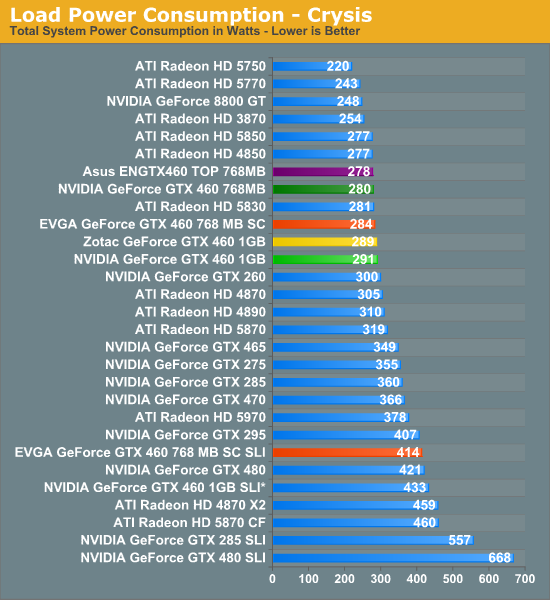
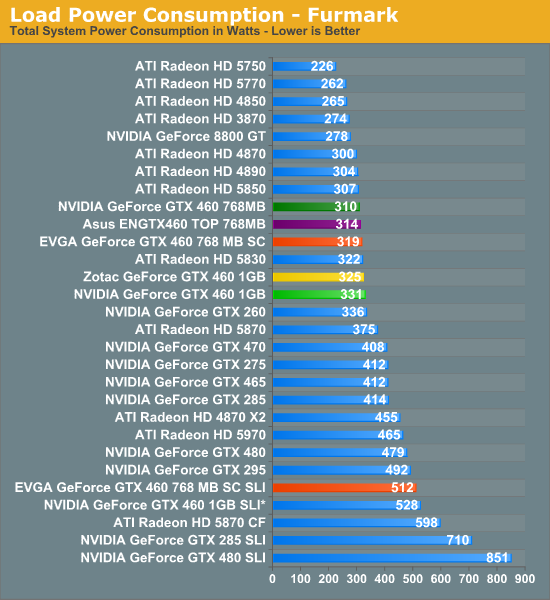
When looking at load power consumption, it’s always interesting to compare the power drawn with the temperatures. While the GTX 460 did very well here with regard to temperature, its power consumption reflects the fact that its GPU is still Cypress-sized. Under Crysis at a 280W load the 768MB part is comparable to the Radeon 5830 and the 1GB part adds around 10W to that. Meanwhile the Radeon 5850 manages to pull just a bit less power here, while the GTX 465 draws some 60W-70W more than the GTX 460. Gmae performance with those two cards may be close – power consumption is not.
As for Furmark the power consumption goes up but the ordering does not. Our 1GB cards now draw 20W more than 768MB cards, but the Radeon 5830 is still in the middle of the pack while the Radeon 5850 comes out ahead. The GTX 465 is now 80W-100W hotter than the GTX 460. Overall with a “proper” Radeon 5000 series card NVIDIA still can’t match AMD on a performance per watt basis, but they can come very close.
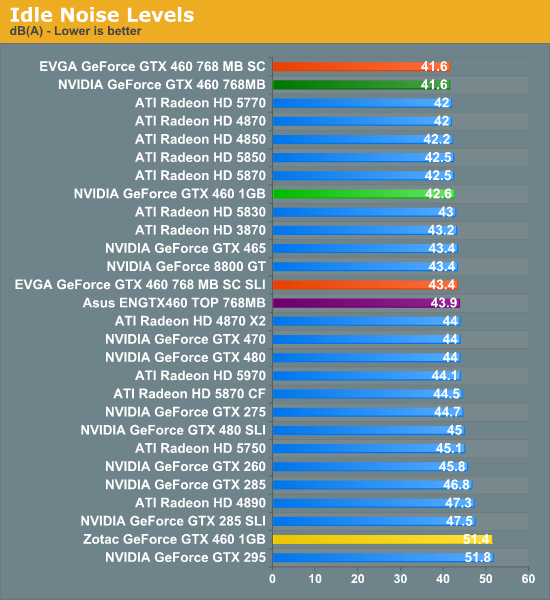
Finally we have our look at noise. With cool running cards we often have to look at fan noise to ensure that they aren’t accomplishing that trick by sounding like a jet engine, and in the case of the GTX 460 that’s clearly not the case. Besides being some of the coolest cards we’ve tested at this performance level the GTX 460 cards are also just as quiet as the rest of the best of the cards we’ve tested, hugging the 42dB sound floor in our testing environment. The 1GB reference card is marginally louder, while the partner customized cards are only slightly louder yet. The only card to really flop here is the Zotac GTX 460, which is at entirely the wrong end of our charts. Blowers can be quiet, but the Zotac’s is not – it’s simply a loud card. Unfortunately this kind of an idle noise level is going to put the card out of the running for a lot of buyers.
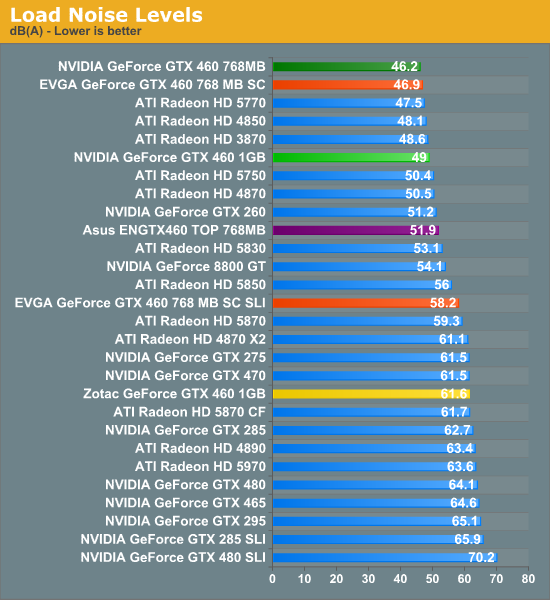
Load noise is more or less like our idle noise results. The 768MB GTX 460 registers the lowest result we’ve ever seen for a card of this performance level, coming in at 46.2dB and the EVGA card right behind it. The 1GB card does end up being louder (likely to compensate for cooling 2 more GDDR5 chips) but it’s still in good company. Asus’s card cracks 50dB, as it’s tuned for cooling over noise, explaining our earlier temperature results. Unfortunately the Zotac card is once again the odd man out at 61dB, roughly as loud as our GTX 470 is. It’s neither cooler than our reference cards nor quieter, which doesn’t bode well for this stock-clocked card.










93 Comments
View All Comments
DominionSeraph - Tuesday, July 13, 2010 - link
Nvidia hit a wall with the GF100, and there really isn't much demand for greater than 4870 performance so ATi can sit on its 5000 series.Wait till the next expansion of WoW comes out and we might see a push for more.
7Enigma - Tuesday, July 13, 2010 - link
I was going to post exactly this. I also built my gaming rig in Jan 09 with a 4870 that I belive was $180 after a $20 rebate, but it was a Sapphire Toxic (factory OC'd with heatpipe).I was shocked to see how little performance improvement could be had for the same money today. I would have expected at least a minimum of 25% and more like 50% improvement across the board.
And I bought the 4870 when the 4890 was just coming out so it's really 2-2.5 years old tech only slightly being outperformed.
The0ne - Monday, July 12, 2010 - link
I really appreciate the work done on the tests and especially the charts. I'm glad to see my somewhat aging 4870 on the list for comparison. Seems like I'll be handing it over to my nephews in favor of a 5870 soon. Just waiting and hoping for prices to drop in the next month or so. Crossing fingers!Interitus - Monday, July 12, 2010 - link
This is my gripe with the reviews lately. Your aging 4870 is on that list, yet we can't get a 5850 CF number??? Really??? There's even a 3870 in some bench charts..Not like I can't go look it up somewhere else, but it's pretty ridiculous that 5850 CF seems to always be missing. I have one and am considering two. It would be nice to see how 460 1GB SLI fared alongside 5850 CF.
The0ne - Tuesday, July 13, 2010 - link
The issue you've mentioned plagues many, if not ALL, online reviews. I truly cannot understand why they can't or won't include suitable video cards for comparisons. The only difficulty is to maintain the test setups are the same, otherwise keeping the info in a database and updating it is rational. Even with the charts here, some cards are listed and then not listed in other charts.I have 30" screens so I mostly view the highest resolution performance charts but even then I have to resort lower resolutions to find cards I'm interested in. I'm just thankful that if Anand is missing what I need, I can go to other sites and pray to God I can find it there AND be able to make a reasonable comparison (test setups and such differing).
Mr Perfect - Monday, July 12, 2010 - link
I'm glad to see a component review on AT again. Every day for what feels like an eternity now, it's been nothing but cell phones, laptops, pre-built rigs, and all manner of factory assembled consumer electronica. I'm off to read the vendor-specific 460 article now!futurepastnow - Monday, July 12, 2010 - link
Looks like Nvidia should have called it the Geforce HD 3870 ;)Hrel - Monday, July 12, 2010 - link
Why does the 768MB card keep beating the 1GB card?Ryan Smith - Tuesday, July 13, 2010 - link
On which charts are you seeing that?Poisoner - Tuesday, July 13, 2010 - link
This makes me wish I had an nVidia based chipset. I guess 2 4870s will have to do.